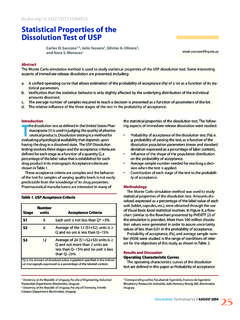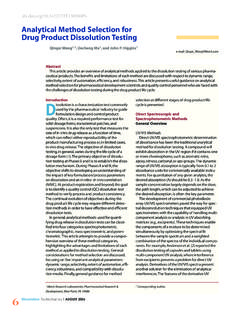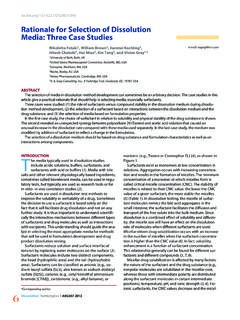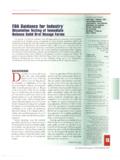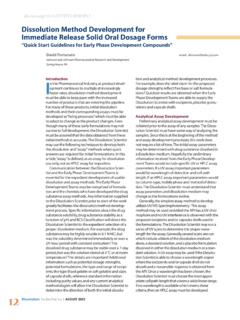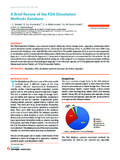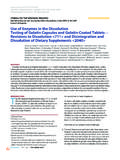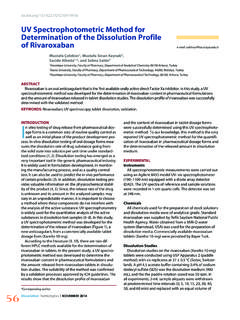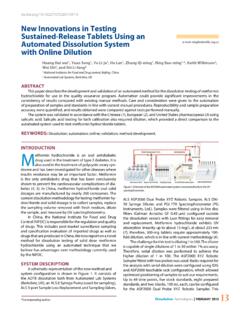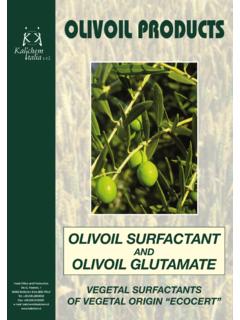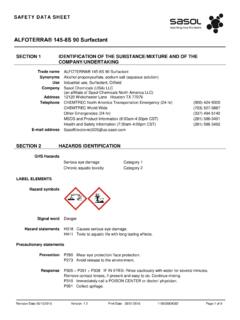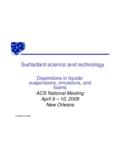Transcription of Effects of Dissolved Gases in Surfactant Dissolution …
1 6 DissolutionTechnologies| AUGUST 2005 Effects of Dissolved Gases in SurfactantDissolution media Kyle A. Fliszar*, Richard J. Forsyth, Zhong Li, Gregory P. MartinPharmaceutical Analysis & Control, PR&D, Merck & Point, PA, Gases , with Dissolved oxygen servingas the primary marker, have been widelydocumented to influence Dissolution experi-ments. The Dissolved Gases can cause changes inthe performance of the Dissolution medium bychanging pH, forming bubbles on the dosage formor altering the interaction of the medium and theactive pharmaceutical ingredient [1]. Extensivestudies have been performed examining appro-priate techniques for the removal of Dissolved gasesfrom aqueous media which include a combinationof heating and vacuum filtration followed by stirringunder vacuum (USP method), vacuum filtration,heating alone, sonication, helium sparging, andmembrane filtration [2-6].
2 Regardless of technique, reaeration of the media isa concern. Reaeration can be defined as the processof Gases from the atmosphere dissolving into theliquid phase raising the level of Dissolved have shown that regardless of techniqueused to remove Dissolved Gases , reaeration willoccur, and the equilibrium Dissolved oxygen valuewill be relatively unaffected [7]. The only influencethe technique will have is the amount of dissolvedgas removed, and the time it will take for the mediato equilibrate to atmospheric conditions. media thathave reached equilibrium do not exhibit perfor-mance changes stemming from the technique usedto remove the Dissolved the effect of Dissolved Gases on aqueousmedia has been studied extensively, the effect onsurfactant containing media has not beenaddressed directly.
3 The USP General Chapter <711>states, Dissolved Gases can cause bubbles to form,which may change the results of the test. In suchcases, Dissolved Gases should be removed prior totesting [8]. This statement does not specify type ofmedia, but suggests that if Dissolved Gases do notaffect the results, the level of Dissolved Gases can belargely study investigates whether the level ofdissolved Gases is a source of variability that shouldbe monitored when performing Dissolution teststhat utilize a Surfactant -containing medium byexamining the Dissolution performance of oraldosage forms in media with a range of dissolvedoxygen levels. Furthermore, the USP method ofdissolved Gases removal along with other acceptedmethods will be examined to determine their influ-ence on equilibrium values of Dissolved Equilibration Study-Three representative Surfactant -containingdissolution media were prepared in water: dodecylsulfate (Sigma Chemical Co.)
4 , , MO), sodium dodecylsulfate and 80 ( TCI, Tokyo, Japan). The first treatment ofmedia was placed in Dissolution vessels immedi-ately after preparation, the media were agitated at50 rpm using Apparatus II. A second treatment ofmedia was sparged with helium for 5 and 30minutes after preparation and then placed in disso-lution vessels and agitated at 50 rpm using appa-ratus II after each treatment. A third treatment ofmedia was prepared according to the USPdegassing procedure, placed in Dissolution vesselsand agitated at 50 rpm using Apparatus II. Thedissolved oxygen content of all three media wasmeasured upon placement in the vessels, and atpredetermined timepoints (Figure 1-3).
5 Only theUSP method of degassing required preheating ofthe media , all other treatments were placed in thevessels at room temperature. The Dissolved oxygencontent was determined using the Winkler titrationmethod [9,10].All Dissolved oxygen measurements wereAbstractThe Effects of Dissolved Gases on the performance of aqueous Dissolution media have been studied exten-sively, but little has been published regarding the effect of Dissolved Gases on Surfactant containing dissolu-tion media . There are various methods available to control the level of Dissolved Gases in Surfactant media ,but regardless of the method used or level of Dissolved Gases achieved, the media will equilibrate to atmos-pheric conditions within approximately one hour.
6 Therefore, elaborate techniques to control the level ofdissolved Gases are unnecessary, and the variability associated with Dissolved Gases can be minimized byperforming the Dissolution experiment at : AUGUST 2005conducted using the Winkler titration method. Attemptswere made at using Dissolved oxygen meters, but unex-pected and inconsistent values were obtained. It issuspected that the presence of the Surfactant interferedwith the probe on the Dissolved oxygen meter. The Winklertitration is a reaction between manganese and oxygen andis not likely to be affected by other components of the of Dissolved Gases Content on Dissolution RateTo determine if the level of Dissolved Gases affects surfac-tant media differently than aqueous media , the series ofexperiments described below was conducted.
7 The experi-ments were conducted side by side using media that hadbeen treated by helium sparging, and media that was leftuntreated (unless otherwise stated). The Dissolved oxygencontent was measured upon preparation and at the start ofthe Dissolution examine if any Effects from Dissolved Gases weredependent upon dosage form, a series of experiments wasconducted using three different dosage forms. First,compound A (a compressed tablet with a 10% drug loadand standard pharmaceutical excipients) was method utilizes sodium dodecyl sulfate (50 rpm,Apparatus II) and the Dissolved oxygen content at the startof experiments was mg/L and mg/L for theuntreated and helium sparged media respectively.
8 The % ofcompound A released was monitored by HPLC-UV at 10, 15,20, 30, 45 and 60 minutes (Figure 4).Next, compound B (a film coated tablet with a 25% drugload and standard pharmaceutical excipients) was exam-ined. This method utilizes sodium dodecyl sulfate (75rpm, Apparatus II) and the Dissolved oxygen content at thestart of the experiment was mg/L and mg/L for theuntreated and helium sparged media respectively. Thepercent of compound B released was monitored by HPLC-UV at 10, 15, 20, 30 and 45 minutes (Figure 5). Finally, aFigure 1. Dissolved oxygen equilibration in Tween 2. Dissolved oxygen equilibration in SDS mediaFigure 3. Dissolved oxygen equilibration in SDS 5.
9 Release profile of compound B in helium sparged and SDS 4. Release profile of compound A in helium sparged and SDS with two active components, compound C(10% drug loading) and compound D (5% drug loading) in ahard gelatin capsule was examined. This method Tween 80 medium (in 25 mM NaH2PO4, pH , 100rpm, Apparatus II) and the Dissolved oxygen content at thestart of the experiment was mg/L and mg/L for theuntreated and helium sparged media respectively. Thepercent of compounds C and D released was monitored byHPLC-UV at 10, 15, 20, 30, 45 and 60 minutes (Figures 6 and 7).A second set of experiments was conducted to examinethe effect of Dissolved Gases on a product that was knownto be influenced by Dissolved Gases in aqueous media .
10 Thisexperiment involved the USP calibrator prednisone tabletformulation. The formulation is used to calibrate dissolutionbaths, and its release rate is known to be influenced by thelevel of Dissolved Gases in water. Although the standarddissolution method does not call for surfactants to be used,the experiment was performed with very low levels ofsurfactant ( and SDS in water). Along withsparged media , aerated media were used in place ofuntreated media to maximize the difference in dissolvedoxygen levels. The aerated media were generated bybubbling air through the media for 2 minutes. The dissolvedoxygen content at the start of the experiment using was mg/L and mg/L for the aerated and heliumsparged media respectively.
